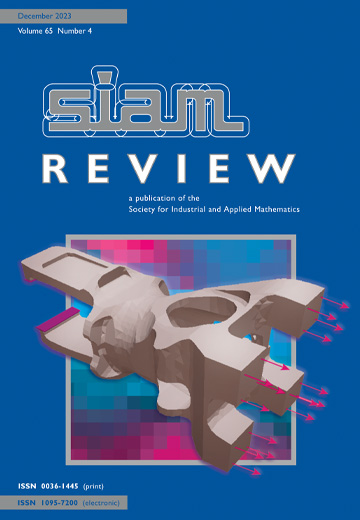大规模逆问题的计算方法:混合投影方法概览
IF 6.1
1区 数学
Q1 MATHEMATICS, APPLIED
引用次数: 0
摘要
SIAM Review》,第 66 卷第 2 期,第 205-284 页,2024 年 5 月。 本文研究了一类重要的方法,它们结合了迭代投影方法和变分正则化方法来解决大规模逆问题。克雷洛夫子空间法等迭代法在数值线性代数领域非常宝贵,由于其固有的正则化特性和处理大规模问题的能力,已被证明在求解逆问题中非常重要。变分正则化描述了一类广泛而重要的方法,用于获得逆问题的可靠解,即解决一个包含先验知识的修正问题。混合投影方法将迭代投影方法与变分正则化技术协同结合,为研究人员提供了解决超大逆问题的强大计算框架。虽然针对线性逆问题的混合克雷洛夫方法的想法可以追溯到 20 世纪 80 年代,但最近在新的正则化框架和方法论方面取得的一些进展使这一领域的扩展、进一步分析和新应用时机已经成熟。在本文中,我们以求解大型(线性)逆问题为背景,对混合投影方法进行了实用、易懂的介绍。本文章由计算机程序翻译,如有差异,请以英文原文为准。
Computational Methods for Large-Scale Inverse Problems: A Survey on Hybrid Projection Methods
SIAM Review, Volume 66, Issue 2, Page 205-284, May 2024.
This paper surveys an important class of methods that combine iterative projection methods and variational regularization methods for large-scale inverse problems. Iterative methods such as Krylov subspace methods are invaluable in the numerical linear algebra community and have proved important in solving inverse problems due to their inherent regularizing properties and their ability to handle large-scale problems. Variational regularization describes a broad and important class of methods that are used to obtain reliable solutions to inverse problems, whereby one solves a modified problem that incorporates prior knowledge. Hybrid projection methods combine iterative projection methods with variational regularization techniques in a synergistic way, providing researchers with a powerful computational framework for solving very large inverse problems. Although the idea of a hybrid Krylov method for linear inverse problems goes back to the 1980s, several recent advances on new regularization frameworks and methodologies have made this field ripe for extensions, further analyses, and new applications. In this paper, we provide a practical and accessible introduction to hybrid projection methods in the context of solving large (linear) inverse problems.
This paper surveys an important class of methods that combine iterative projection methods and variational regularization methods for large-scale inverse problems. Iterative methods such as Krylov subspace methods are invaluable in the numerical linear algebra community and have proved important in solving inverse problems due to their inherent regularizing properties and their ability to handle large-scale problems. Variational regularization describes a broad and important class of methods that are used to obtain reliable solutions to inverse problems, whereby one solves a modified problem that incorporates prior knowledge. Hybrid projection methods combine iterative projection methods with variational regularization techniques in a synergistic way, providing researchers with a powerful computational framework for solving very large inverse problems. Although the idea of a hybrid Krylov method for linear inverse problems goes back to the 1980s, several recent advances on new regularization frameworks and methodologies have made this field ripe for extensions, further analyses, and new applications. In this paper, we provide a practical and accessible introduction to hybrid projection methods in the context of solving large (linear) inverse problems.
求助全文
通过发布文献求助,成功后即可免费获取论文全文。
去求助
来源期刊

SIAM Review
数学-应用数学
CiteScore
16.90
自引率
0.00%
发文量
50
期刊介绍:
Survey and Review feature papers that provide an integrative and current viewpoint on important topics in applied or computational mathematics and scientific computing. These papers aim to offer a comprehensive perspective on the subject matter.
Research Spotlights publish concise research papers in applied and computational mathematics that are of interest to a wide range of readers in SIAM Review. The papers in this section present innovative ideas that are clearly explained and motivated. They stand out from regular publications in specific SIAM journals due to their accessibility and potential for widespread and long-lasting influence.
 求助内容:
求助内容: 应助结果提醒方式:
应助结果提醒方式:


